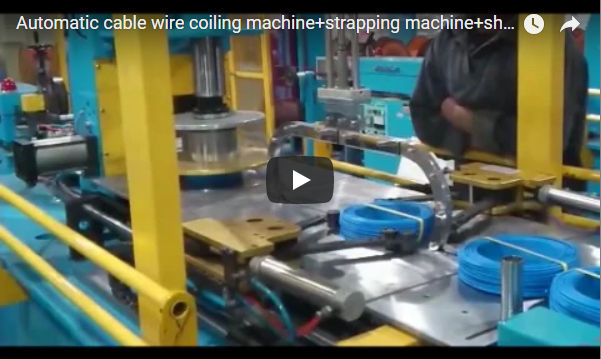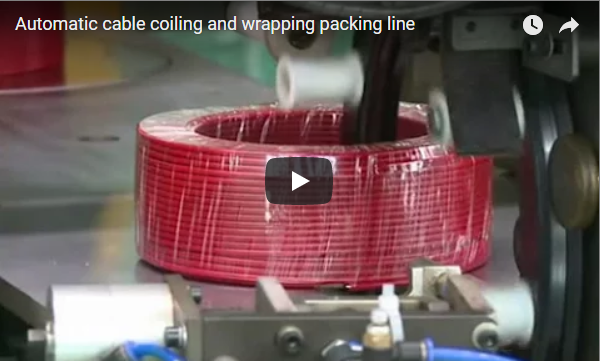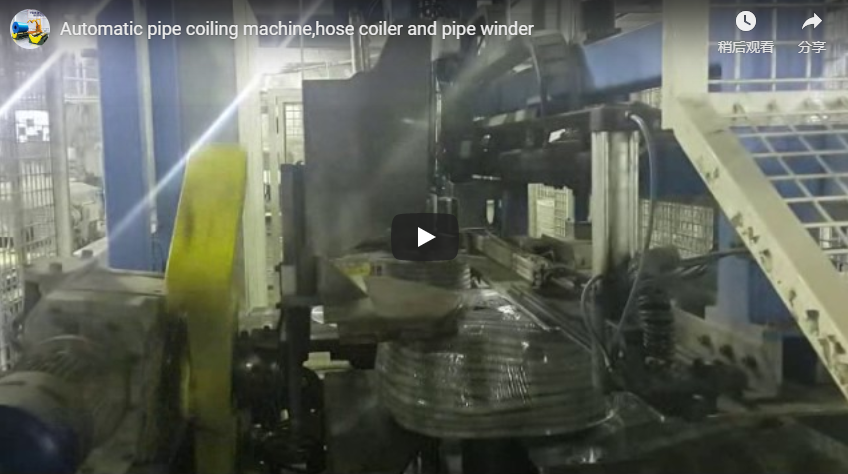1. Revolutionizing Cable Handling: The Fully Automated Coiling, Strapping, Shrinking, and Palletizing Line
Welcome to an in-depth look at a state-of-the-art Auto Online Cable Coiling, Strapping, Shrinking, and Palletizing Stacking Packing Line. This integrated system represents a significant leap forward in industrial automation, specifically designed to streamline and optimize the end-of-line packaging process for cable and wire products. By automating critical steps from coiling to palletizing, this solution addresses key operational inefficiencies, enhances product protection, and boosts overall throughput, offering substantial value in demanding industrial environments like those found in cable manufacturing and distribution hubs.
2. Addressing Critical Challenges in Cable Logistics
Manual and semi-automated cable packaging processes often encounter persistent challenges that impact efficiency, cost, and product quality. Key issues include:
- Inconsistent Coil Quality: Manual coiling struggles to maintain uniform tension and layering, leading to loose or unevenly wound coils. This is particularly challenging with small diameter cables, where controlling the inner diameter is crucial for stability.
- Throughput Bottlenecks: Manual handling between coiling, strapping, wrapping, and palletizing creates significant delays, limiting overall production output. Coils loosening before strapping further exacerbates these delays.
- Labor Intensity and Ergonomic Risks: Repetitive manual lifting, bending, and strapping tasks are labor-intensive and pose ergonomic risks to workers.
- Packaging Integrity: Improperly strapped or wrapped coils are susceptible to damage during storage and transit. Manual palletizing often results in unstable stacks prone to collapse.
- Material Waste: Inconsistent strapping tension or shrink wrapping can lead to excessive material usage.
This automated packing line is engineered to directly overcome these obstacles, providing a robust and reliable alternative.
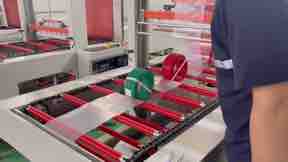
3. System Overview: Design, Components, and Workflow
This fully automated line integrates multiple processes into a seamless workflow, typically managed by a central Programmable Logic Controller (PLC) and Human-Machine Interface (HMI).
3.1 Coiling Station
- Function: Receives cable directly from the production line (extruder) or a payoff stand.
- Mechanism: Precisely winds the cable into coils of predetermined length and diameter. Incorporates features like automatic layering and tension control systems to ensure tight, uniform coils. Includes automatic cutting upon reaching the target length.
- Components: Servo-driven coiling head, traversing unit for layering, dancer arm or electronic tension control, length counter, cutter mechanism.
3.2 Strapping Unit
- Function: Automatically applies and secures straps around the finished coil to maintain its shape and prevent unwinding.
- Mechanism: Transports the coil from the coiling station. Typically uses PP or PET straps, applying them at programmed intervals (e.g., 2 or 4 straps per coil). Heat sealing or friction welding secures the straps.
- Components: Conveyor system, coil centering device, strapping head (e.g., Signode, Mosca or equivalent), strap dispenser.
3.3 Shrink Wrapping Module
- Function: Encloses the strapped coil in protective shrink film.
- Mechanism: The coil is fed into a wrapping station where PE shrink film is applied. It then passes through a heat shrink tunnel where controlled hot air circulation shrinks the film tightly around the coil, providing environmental protection and stability.
- Components: Infeed/outfeed conveyors, film sealing bar, film roll holder, shrink tunnel with heating elements and blowers, temperature control system.
3.4 Robotic Palletizing Cell
- Function: Automatically stacks the finished, wrapped coils onto pallets according to pre-programmed patterns.
- Mechanism: An industrial robot arm, equipped with a suitable gripper (customized for coil handling), picks individual coils from the shrink wrapper's outfeed conveyor and places them onto a pallet located within the robot's work envelope. Layer patterns are optimized for stability and density. Full pallets are automatically discharged.
- Components: 6-axis industrial robot (e.g., Fanuc, KUKA, ABB or equivalent), specialized end-of-arm tooling (gripper), pallet dispenser, accumulation conveyors for finished coils, discharge conveyor for full pallets, safety fencing and sensors.
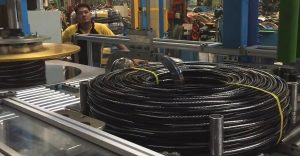
4. Technical Specifications and Performance Data
The system offers significant flexibility through adjustable parameters to suit diverse production needs. Key specifications include:
| Parameter | Specification Range | Notes |
|---|---|---|
| Line Speed | 20 - 60 coils/hour | Adjustable based on coil size & complexity |
| Coil OD | 300 - 450 mm | Accommodates various product sizes |
| Coil Width/Height | 50 - 200 mm | Adjustable coiling parameters |
| Strapping Material | PP / PET | Standard industrial strapping |
| Strap Width | 9 - 19 mm | Configurable based on requirement |
| Strap Thickness | 0.55 - 1.05 mm | Configurable based on requirement |
| Shrink Film Material | PE | Standard shrink film type |
| Film Thickness | 35 - 100 μm | Wide range for different protection levels |
| Max Film Width | 50 - 1000 mm | Accommodates various coil dimensions |
| Robot Payload Capacity | 50 - 200 kg | Selected based on max coil weight |
| Robot Reach | 1000 - 3000 mm | Determined by cell layout and pallet size |
| Control System | PLC (e.g., Siemens, Allen-Bradley) + Touch Screen HMI | Provides central control and monitoring |
| Power Supply | Typically 380V/480V, 3-Phase, 50/60Hz | (Verify specific requirements) |
| Compressed Air | Typically 6-8 bar | (Verify specific consumption) |
Note: Specifications can be customized based on specific application requirements. Consult manufacturer documentation for precise data.
5. Key Operational Benefits and ROI Considerations
Implementing this automated line delivers tangible benefits:
- Enhanced Packaging Protection: Consistent strapping and tight shrink wrapping ensure coils are secure, minimizing damage during handling, storage, and transportation.
- Increased Efficiency & Throughput: Automating the entire sequence significantly reduces cycle times compared to manual or semi-auto methods, boosting overall output. Line speeds of up to 60 coils/hour drastically improve productivity.
- Reduced Labor Costs: Minimizes the need for manual labor in repetitive and physically demanding tasks, allowing personnel to be reassigned to higher-value roles.
- Improved Consistency and Quality: Automation eliminates human variability, ensuring every coil is packaged to the same high standard. Precise tension control and layering create superior coil integrity.
- Enhanced Safety: Reduces manual handling risks associated with lifting heavy coils and operating strapping/wrapping equipment. Robotic cells operate within safety-interlocked enclosures.
- Optimized Material Usage: Automated systems can be fine-tuned for precise strap tension and film usage, reducing waste.
- Improved Marketing & Brand Image: Professionally coiled, strapped, and wrapped products project a higher quality image, enhancing customer perception and satisfaction.
- Favorable ROI: The combination of reduced labor costs, increased throughput, minimized product damage, and improved safety contributes to a strong return on investment.
6. Real-World Application & User Experience
This type of automated line is ideally suited for medium-to-high volume cable manufacturers and distributors.
- Integration: Designed for seamless integration into existing production workflows, often receiving cable directly from extruders or intermediate payoff systems. Communication protocols (e.g., EtherNet/IP, Profinet) allow integration with plant-level control (MES/ERP) systems for tracking and data exchange.
- Operation: Managed via a user-friendly HMI (Touch Screen) that allows operators to select recipes (pre-programmed settings for different products), monitor system status, adjust parameters, and troubleshoot alarms.
- Maintenance: Designed with accessibility for routine maintenance. Key components are typically standard industrial parts, ensuring availability. Predictive maintenance alerts can often be programmed based on cycle counts or runtime. Training for operators and maintenance staff is usually provided by the supplier.
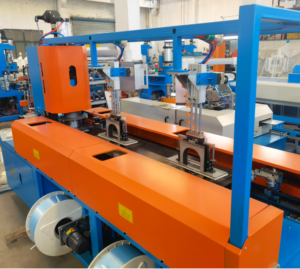
automatic cable coiling2 7. Ensuring Quality and Compliance
The automated system ensures consistent adherence to packaging specifications, contributing to overall quality management. Securely packaged coils meet transportation and storage requirements, reducing the risk of non-compliance or customer complaints related to damaged goods. The system can help meet internal quality standards as well as external expectations for product presentation and integrity. ([Link to relevant packaging standards, e.g., ASTM, could be added here]).
8. Frequently Asked Technical Questions (FAQs)
1. How does the machine ensure consistent coil tension?
The coiling station utilizes servo-driven controls and dancer arms or electronic feedback systems to precisely regulate winding tension throughout the coiling process, preventing loose layers.
2. Can the system handle different cable types and sizes?
Yes, the line is designed with adjustable parameters (coil diameter, width, strap positions, shrink parameters, robot patterns) easily selectable via the HMI through pre-saved recipes, accommodating a wide range of cable products.
3. What safety features are incorporated, particularly around the robot?
The robotic cell is enclosed by safety fencing with interlocked access gates. Light curtains, area scanners, and emergency stop circuits are integrated according to international safety standards (e.g., ISO 10218) to protect personnel.
4. What is the typical footprint and installation requirement?
The footprint varies depending on the specific configuration (e.g., conveyor lengths, robot reach). A detailed layout drawing is typically provided. Installation involves mechanical assembly, electrical connections, compressed air supply, and system commissioning, usually requiring several days to a few weeks depending on complexity.
5. What are the typical maintenance requirements?
Routine maintenance includes lubrication, inspection of wear parts (strapping head components, cutter blades, conveyor belts), sensor cleaning, and filter changes. A detailed maintenance schedule is provided by the manufacturer. ([Link to example maintenance best practices or manufacturer support page could be added here]).
6. Can this system integrate with our existing factory network or MES?
Yes, modern systems typically offer standard industrial communication protocols (like EtherNet/IP, Profinet, Modbus TCP) enabling data exchange for production monitoring, recipe management, and operational status reporting.
9. Next Steps: Consultation and Demonstration
To explore how this Auto Online Cable Coiling, Strapping, Shrinking, and Palletizing Stacking Packing Line can transform your cable packaging operations, we encourage you to take the next step:
- Request a Custom Quote: Contact us with your specific requirements (cable types, sizes, desired throughput, existing layout constraints) for a tailored proposal.
- Schedule a Consultation or Demo: Discuss your application in detail with our automation specialists. If feasible, arrange a visit or online demonstration to see the system's capabilities firsthand.
Reach out today to discover how automation can significantly enhance your efficiency, quality, and bottom line in cable logistics.


